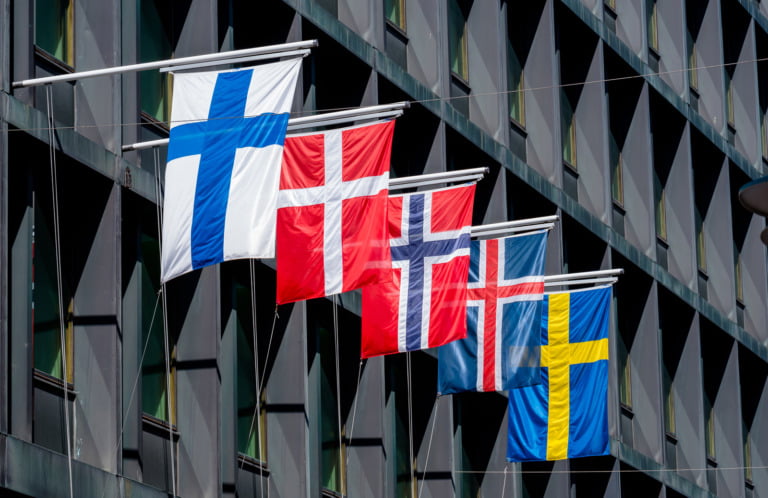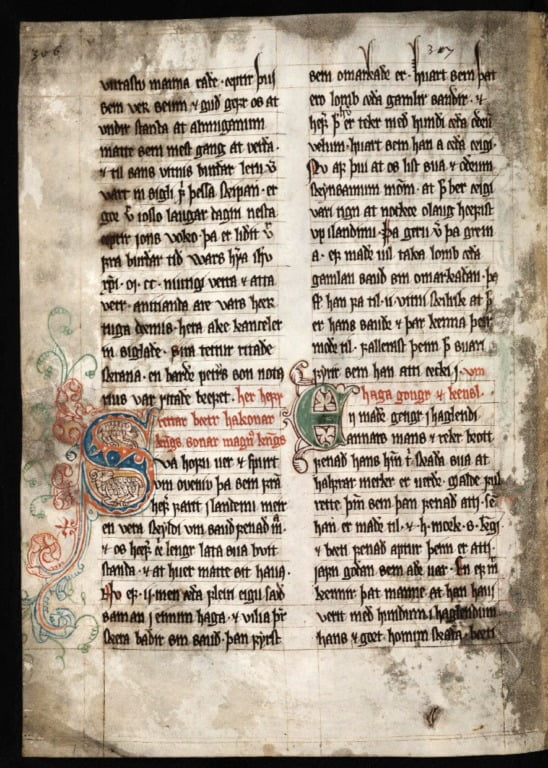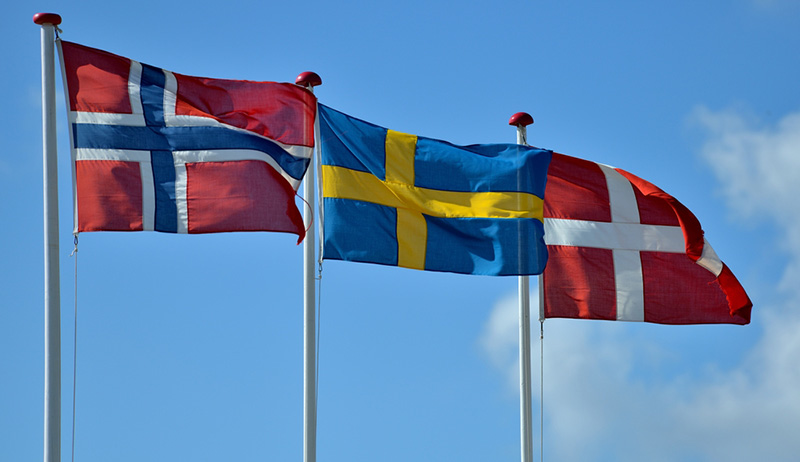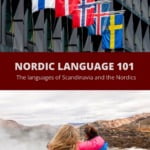From Old Norse and Icelandic to Sami, discover the fascinating linguistic landscape of Northern Europe and how centuries of history have shaped the way people speak today.
When we talk about the Nordic languages, we usually mean Danish, Norwegian, Swedish, Icelandic, and Faroese. These five languages are spoken by around 19 million people across the Nordic region and form the foundation of its shared linguistic heritage.

However, they are not the only languages you’ll hear in the north. Finnish is spoken by nearly six million people and holds official status in both Finland and parts of Sweden.
Several Sami languages are used in the far north of Norway, Sweden, and Finland. Other minority languages, including Kven, Meänkieli, and Greenlandic, also have a foothold.
And while not native, English plays an increasingly important role in everyday life, particularly among younger generations.
In this article, we take a closer look at the languages of the Nordic region. From the shared roots of the Viking Age to the complex linguistic landscape of today, language continues to shape identity, culture, and communication across the north.
How History Shaped Nordic Language
Centuries ago, many people in the Nordic countries could understand one another without much difficulty. This was largely due to the widespread use of Old Norse, which served as a common language across Scandinavia during the Viking Age and beyond.
Political history has played a major role in shaping the modern languages. Norway, for example, spent centuries in union with first Denmark and later Sweden.
These long-standing relationships influenced both vocabulary and spelling in the written form of Norwegian, especially what we now call Bokmål.
Despite being separate nations today, the Nordic countries have maintained a degree of mutual understanding through language. Shared literature, similar grammar, and overlapping vocabulary have all helped to strengthen cultural ties throughout the region.
Language Families of the North
Most of the Nordic languages belong to the North Germanic branch of the Indo-European language family. This group includes Icelandic, Faroese, Norwegian, Danish, and Swedish.

These languages all trace their origins back to Old Norse, the language of the Vikings.
Norwegian, Danish, and Swedish are especially close, and many speakers can understand each other to varying degrees. These three languages are often grouped together under the term “Scandinavian languages.”
However, not all languages in the Nordic region share this Germanic background. Finnish and the Sami languages belong to the Uralic language family, which has no relation to the Germanic tongues.
Despite this difference, these languages have long existed alongside their neighbours and continue to play an important role in regional identity.
Today, Danish, Finnish, and Swedish are also official languages of the European Union, reflecting their broader significance beyond the region.
Old Norse: The Common Ancestor
Old Norse was the language spoken across much of Scandinavia and Iceland during the Viking Age and the early medieval period. It was also used in many overseas settlements, from the British Isles to Greenland.
Over time, Old Norse began to evolve, eventually giving rise to the modern North Germanic languages spoken today.
One of the most fascinating things about Old Norse is its variety. It was written using runes known as Younger Futhark before eventually transitioning to the Latin alphabet.
The language also had two main dialects: a western form, which led to Icelandic, Faroese, and Norwegian, and an eastern form, which evolved into Swedish and Danish.

Old Norse did not vanish overnight. Linguists generally mark the 14th and 15th centuries as the period when it transitioned into the early forms of the modern languages.
Its influence lives on, not only in the Nordic region but also in the English language. Many common English words, including some place names and even basic pronouns, have roots in Old Norse.
The eastern dialect led to the Swedish and Danish we know today. The western variety eventually became Icelandic, Faroese and Norwegian, although the latter two are today heavily influenced by modern Danish.
Icelandic and Faroese: The Closest to Old Norse
Spoken only in Iceland, modern Icelandic is the closest language to Old Norse still in use today.
Although elements of the language have developed and no-one is quite sure how Old Norse would have sounded, the grammar and vocabulary remains similar. So much so that Iceland Magazine said modern Icelanders can read the medieval manuscripts “with little difficulty.”
Linguistic experts have previously warned that the Icelandic language is at risk of dying out in modern society. The widespread use of English in the country, both for tourism and for voice-controlled electronic devices, has slowly reduced the numbers of Icelandic-speakers to less than 400,000.
Faroese, spoken by around 72,000 people in the Faroe Islands, is also descended from Old Norse. It shares many features with Icelandic, especially in its written form, but the spoken language is quite distinct.

While the two are related, they are not mutually intelligible in everyday speech.
Both languages are considered somewhat isolated, with limited speakers and little exposure outside their home territories. Despite this, they have strong cultural significance and are actively supported by local governments.
Danish: Norwegian, Swedish: The Scandinavian Core
Norwegian, Danish, and Swedish developed from the eastern and western dialects of Old Norse. Today, they are often referred to collectively as the Scandinavian languages.
These three languages are closely related and are often mutually intelligible, although pronunciation and vocabulary differences can make conversation tricky at times.
Political unions played a major role in shaping these languages. Norway was under Danish rule for hundreds of years, and this is reflected in Bokmål, one of the two official written forms of Norwegian. The spelling and structure of Bokmål closely resembles Danish.
After gaining independence, Norway experienced a strong national movement to promote a distinctly Norwegian written language. This effort led to the creation of Nynorsk, based on rural dialects and traditional Norwegian speech.
According to the Norwegian Language Council, around 10 percent of Norwegians write in Nynorsk today, with most of them living in western regions of the country.
Some linguists argue that Danish, Norwegian, and Swedish could be seen as dialects of a single language. While this may be a stretch, their shared roots and similarities continue to shape communication across national borders.
Can Scandinavians understand each other?
This is a common question, and the answer depends on the languages involved and the individuals speaking them. In general, Norwegians have the easiest time understanding both Danish and Swedish, which is partly due to their exposure to both languages through television, music, and education.

Recent research shows that Norwegian is the most widely understood language in the Nordic region. Around 60 percent of young people from neighbouring countries report finding Norwegian relatively easy to understand.
Danish tends to be the most difficult due to its pronunciation, even though it is grammatically close to both Norwegian and Swedish.
In official Nordic co-operation, Danish, Norwegian, and Swedish are used without interpretation. Finnish and Icelandic speakers, however, are offered interpretation services when attending Nordic Council meetings.
English is often used as a common working language, especially in Nordic–Baltic settings where mutual intelligibility cannot be assumed.
Finnish: A Language Apart
Finnish, or suomi as it is known in the language itself, is spoken by approximately 5.8 million people, primarily in Finland and parts of Sweden.
Unlike the North Germanic languages, Finnish belongs to the Uralic language family, which also includes Estonian, Hungarian, and several indigenous languages of northern Russia.
This means Finnish is not related to its Scandinavian neighbours. It has entirely different roots, grammar, and vocabulary.
For example, Finnish uses a system of grammatical cases instead of prepositions, which can make it more difficult for native English speakers to learn. It also forms long compound words and features sounds that are unfamiliar to many learners.
Despite these differences, Finnish holds an important place in the Nordic language landscape. It is one of the official languages of Finland and also has recognised status in parts of Sweden. Finnish is also an official language of the European Union.
Sami Languages: Indigenous Voices of the North
The Sami languages are also part of the Uralic family, but they form their own distinct group. These languages are spoken by the Sami people, an Indigenous population spread across northern Norway, Sweden, Finland, and the Kola Peninsula in Russia.

In Norway, fewer than 50,000 people speak a Sami language, but the group includes several distinct languages with varying degrees of mutual intelligibility. Some, like Northern Sami, are still used in education and media. Others have only a few remaining speakers or are considered extinct.
The Sami languages are often divided into western and eastern groups, with further subdivisions based on geography and dialect. Because many Sami communities developed in isolation, the differences between these languages can be quite significant.
Since the establishment of the Sami Parliament in Norway in 1989, efforts to preserve and revitalise Sami languages have gained momentum. Government funding supports education, media, and creative projects in Sami.
However, the long-term future of the languages remains uncertain, as younger generations are often more comfortable using Norwegian or Finnish in daily life.
Other Minority & Heritage Languages
In addition to the main national and Indigenous languages, several minority languages are spoken across the Nordic region.
In northern Norway, the Kven language is used by the Kven people, a Finnish-descended minority population. Kven is closely related to Finnish and is sometimes considered a dialect of it, although it contains many Norwegian loan words and retains some archaic Finnish features.
The number of native speakers is estimated at around 10,000, with most of them being older adults. Like many heritage languages, Kven is at serious risk of disappearing.
In Greenland, Greenlandic (known locally as Kalaallisut) is the primary language. It belongs to the Inuit branch of the Eskimo–Aleut language family and is entirely unrelated to the Scandinavian or Uralic languages.
Greenlandic has more in common with Inuktitut and other languages spoken in Arctic Canada and Alaska. It holds official language status in Greenland and is widely used in both public life and education.
Other minority languages include Meänkieli in northern Sweden and Karelian in eastern Finland. These languages are also of Uralic origin and have varying degrees of protection and support within their respective countries.
The Role of English in the Nordic Region
Although English is not an official language in any of the Nordic countries, it plays an increasingly prominent role in daily life, especially among young people and professionals.

In Norway, English is introduced in schools at an early age, often in the first years of primary education. With the widespread influence of English-language media, video games, YouTube, and social media, many Norwegian children grow up fluent in both languages.
English is also widely used in higher education, research, and certain industries such as technology, engineering, and international business. In some companies, English has become the default working language, particularly in sectors that rely on a global workforce.
This widespread use of English has raised concerns about the long-term impact on native languages, especially in Iceland, where experts have warned of a decline in Icelandic use in digital environments and daily conversation.
Which Nordic Language Should You Learn?
If you are planning to move to a Nordic country, the choice is usually straightforward. Learning the local language is the best way to integrate, build relationships, and access opportunities in work and education.
Whether it's Norwegian, Finnish, Swedish, Danish, or Icelandic, making the effort to learn the language spoken around you will open doors and earn respect.
For those with a broader interest in the region, Norwegian is a practical starting point. It sits at the centre of the Scandinavian language group and is considered relatively easy for English speakers to learn.
Because of its similarities with both Danish and Swedish, Norwegian can give you a solid foundation to understand all three languages. I was once told that by learning Norwegian, you get “three for the price of one”—and there’s some truth in that.
If your interest lies more in history, particularly the Viking Age, then Icelandic is worth considering. It preserves many features of Old Norse, making it a fascinating choice for those who want to read medieval texts or understand Viking culture in more depth.
If you do want to start learning Norwegian, head on over here to start. Lykke til!



When my son’s Nordstrand-based soccer (football) team, ages 13-15, returned from a tournament in Denmark, the kids were all rolling their eyes at Danish pronunciations of their essentially shared language. Even my son, whose mastery of Norwegian was marginal at best, added some guttural accentuation.
This is very good, but I have a question. As it happens, I have been a professor of linguistics but not specializing in Scandinavia, and now that I have to write something quickly where I want to quote linguists who say that the three continental Scandinavian languages are really one, I am finding it hard to find such quotes (in any language), though privately over the years some have said so to me. Do you have any good references? Thank you in advance.
Dear sir,
in conversations with people who have English as their first language, and who ask about the difference between Norwegian, Danish and Swedish, I usually say that for all practical purposes, they are three groups of dialects of a common Nordic language. True, the written versions differ, but that is of little practical consequence.
You missed “Älvdalska” a language spoken in northern Dalarna. Älvdalska is a remain of Old Norse (without Flat german influenses) Älvdalska is considered a dialect by Swedish autorities but is seen as a a distinct language internationaly, it have its own code: ISO 639-3 ovd. Älvdalska uses parts of the Futhark alphabet.